Zoho Books update July 2025
We’re excited to share the Zoho Books update July 2025, packed with powerful new features and enhancements designed to help you work smarter, faster, and with more control. From workflow precision and reporting clarity to operational improvements in inventory, billing, and automation — these updates streamline your finance and fulfillment processes, improve decision-making, and reduce manual effort across the board. Here’s a clear breakdown of what’s new, why it matters, and what to do next.
Please note: These features apply to the UK edition of Zoho Books. For region-specific changes, visit your local What’s New Timeline in Zoho Books.
Plan-based trials now available
Zoho Books now lets users test drive any of the five available paid plans — not just the default one. You can now trial Standard, Professional, Premium, Elite, or Ultimate plans directly.
By default, new organisations start on the Premium plan, but switching is quick and accessible.
Explanation of the change
Previously, trial users had limited exposure to Zoho Books’ broader plan capabilities. With this update, you can manually switch between five distinct plans to evaluate the specific features each one offers before committing to a subscription.
Navigation Path:
Click your organisation’s logo (top-right corner) → Change Trial Plan → Choose desired plan → Save
💡 Key Insights
| Category | Details |
|---|---|
| Why it matters | Helps businesses choose the right plan by testing features aligned to their size and needs. |
| How to use it | Use the top-right menu under the organisation logo to change your trial plan in a few clicks. |
| Our opinion | A smart move — more transparency builds confidence and could reduce churn post-trial. |
| What to do next | Try switching between plans to see what each offers. Note what’s missing vs. what’s needed. |
✅ Quick Takeaway
This change empowers better decision-making during onboarding — explore all feature sets without needing multiple accounts or workarounds. Consider documenting must-have features during trial so you’re clear on which plan fits.
New Flow for Tracking Discounts on Bills Under Inventory Asset
Zoho Books now offers a refined flow for tracking line-item discounts on bills. Once enabled, any discounts applied will be automatically reflected in inventory valuations and journals — giving you a more accurate picture of your true inventory cost.
Explanation of the Change
Previously, discounts on line items in bills weren’t consistently tracked in a way that aligned with inventory asset accounting. With the new flow, discounts are now:
- Allocated to the stock account by default
- Reflected in the journal entry for the bill
- Visible in the Inventory Valuation Summary report
This results in a more accurate calculation of your inventory’s true value and cost basis.
💡 Key Insights
| Category | Details |
|---|---|
| Why it matters | Gives a more precise inventory valuation by incorporating line-item discounts directly into assets. |
| How to use it | Switch to the new flow via settings. Then apply discounts as usual — the system handles the rest. |
| Our opinion | A much-needed fix — aligns Zoho Books more closely with accounting best practices. |
| What to do next | Enable the new flow, review its impact in Inventory Valuation reports, and train AP teams accordingly. |
✅ Quick Takeaway
This update improves accounting accuracy for businesses with inventory. Switch to the new flow to ensure your financials reflect real product costs — especially useful for those handling high-volume stock or vendor discounts.
Record Income TDS Without Linking to Invoices
You can now record Tax Deducted at Source (TDS) on income independently of any specific invoice. This adds flexibility for businesses handling advance TDS deductions or bulk payments.
Now, Zoho Books allows you to:
- Record TDS on income separately
- Skip the need for an invoice reference
- Maintain clean, compliant records for reporting and reconciliation
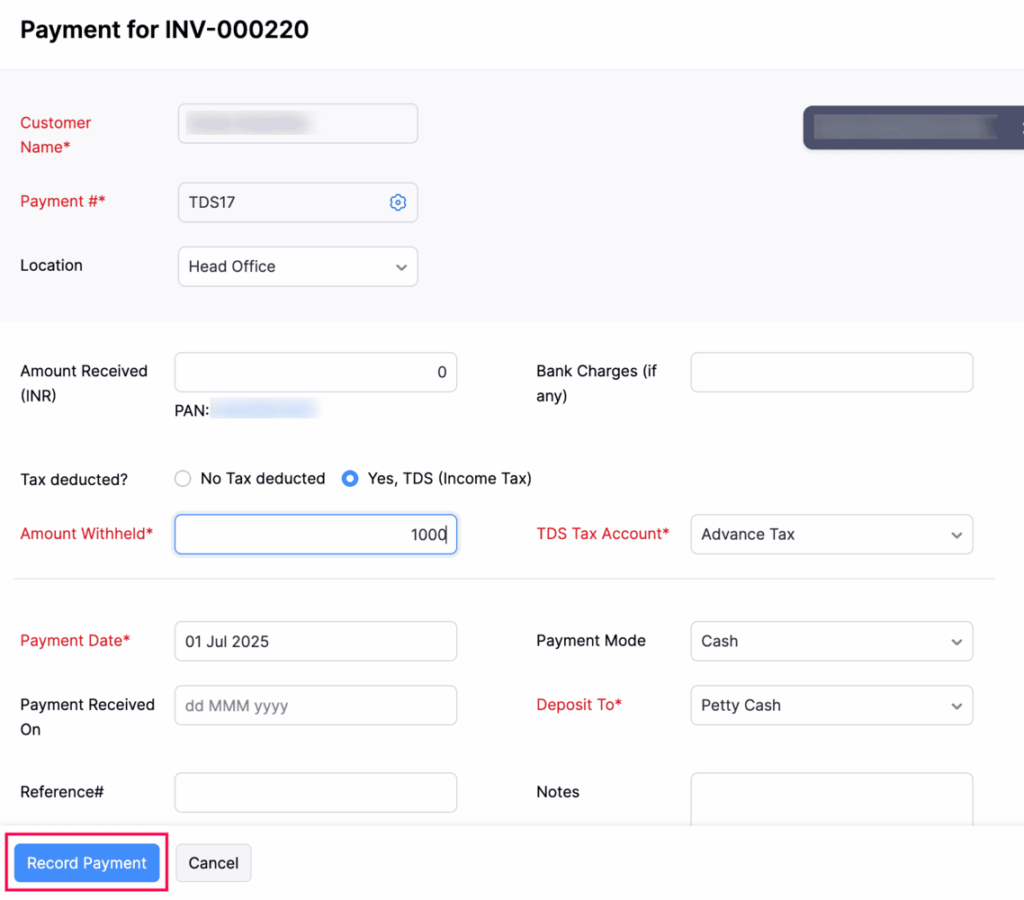
To record a TDS payment without linking it to an invoice, go to Sales > Invoices. Select an invoice, click the Record Payment dropdown, and choose Record Payment. Enter 0 in the Amount Received field, select Yes, TDS (Income Tax) in the Tax Deducted? field, fill in the other mandatory details, and click Record Payment.
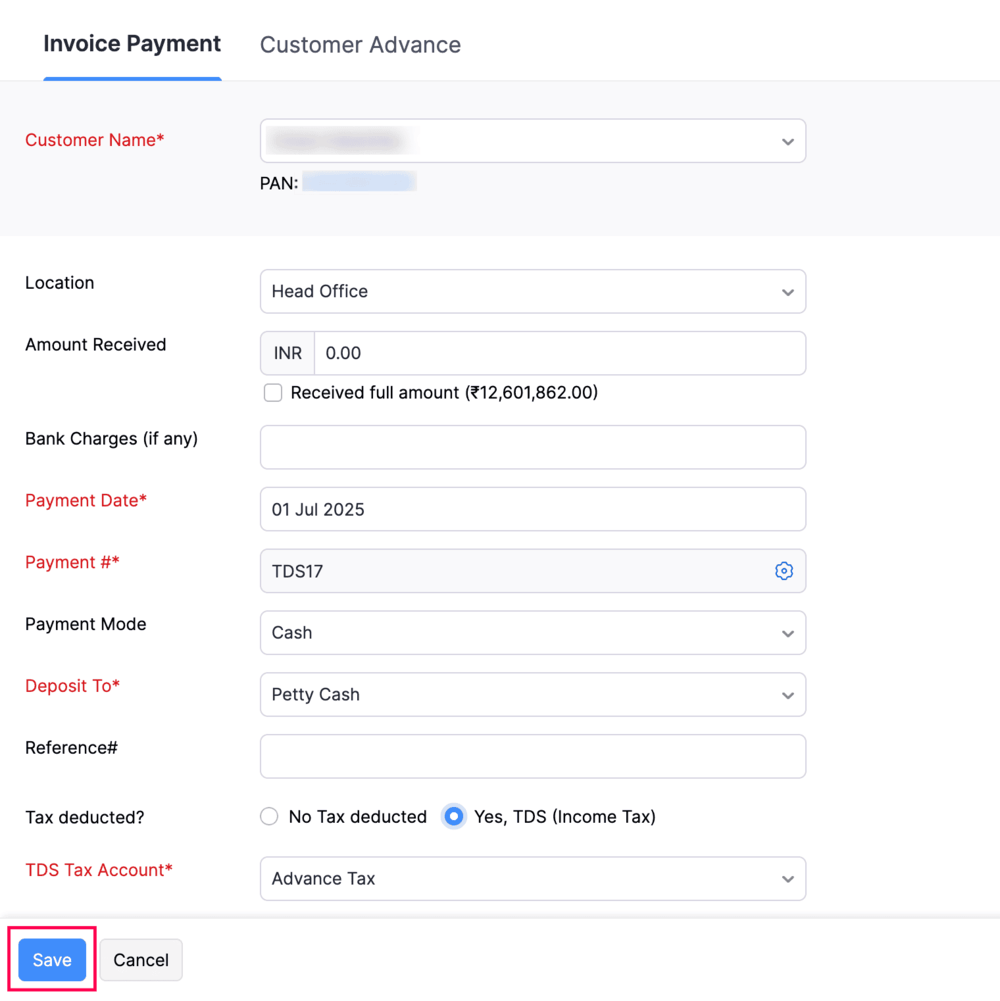
To record a TDS payment without linking it to an invoice from the Payments Received module, go to Sales > Payments Received. Click + New, select a Customer Name, enter 0 in the Amount Received field, fill in the other mandatory fields, and click Save.
💡 Key Insights
| Category | Details |
|---|---|
| Why it matters | Simplifies compliance and accounting for businesses receiving TDS before invoicing. |
| How to use it | Go to the TDS module → Record TDS → Enter income TDS without selecting an invoice. |
| Our opinion | A simple but powerful update — removes a common pain point for Indian businesses. |
| What to do next | Update internal finance processes to reflect this option. Use for pre-invoice TDS receipts. |
✅ Quick Takeaway
This gives more flexibility to manage TDS accurately — especially valuable for firms working with large clients or governments where TDS is deducted at source before formal billing.
Mark PDF Templates as Active or Inactive
You now have the ability to deactivate PDF templates instead of deleting them. Inactive templates are retained in your system but cannot be applied to transactions — and can be reactivated at any time.
Explanation of the Change
Until now, managing unused or outdated PDF templates meant either keeping them cluttering your list — or permanently deleting them. This update introduces a cleaner middle ground:
- Mark templates as inactive to temporarily disable them
- Inactive templates can’t be used for invoices, quotes, or other modules
- Re-enable them later with one click if needed
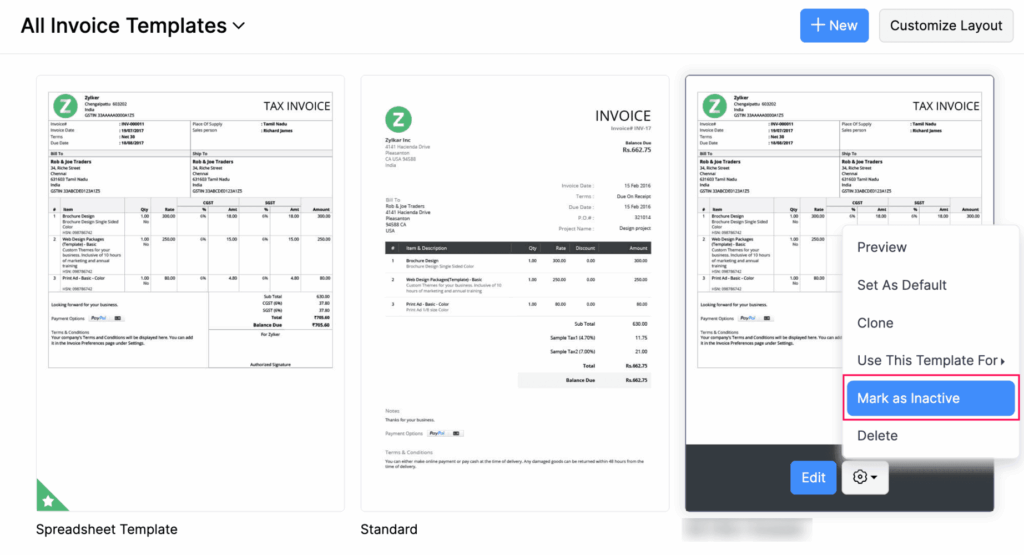
To mark PDF templates as inactive, go to Settings > Customization > PDF Templates. Select a module under the Templates pane, hover over the desired template, click the Settings icon, and select Mark as Inactive from the dropdown.
💡 Key Insights
| Category | Details |
|---|---|
| Why it matters | Helps keep your templates organized without permanent deletion — useful for seasonal or legacy use. |
| How to use it | Go to Settings > Templates, open a template, and use the Active/Inactive toggle. |
| Our opinion | A thoughtful quality-of-life improvement — great for admin hygiene and audit readiness. |
| What to do next | Review existing templates and deactivate ones you no longer use to streamline your workspace. |
✅ Quick Takeaway
Keep your template library clean without losing history. Mark old templates inactive now — and bring them back only when needed.
Time Zone–Based Workflow Rules
You can now configure workflow rules to run based on either your organisation’s time zone or the customer’s time zone — ideal for global operations needing localised automation.
Previously, all workflow automation (e.g. email reminders, alerts) in Zoho Books followed the organization’s time zone, which could cause misaligned triggers for international customers.
With this update, you can now:
- Choose between Org Time Zone or Customer Time Zone per workflow
- Ensure that reminders or actions are triggered at appropriate local times
- Deliver a more timely, tailored experience for global clients
Note: This feature is currently supported only for the Invoices and Sales Orders modules.
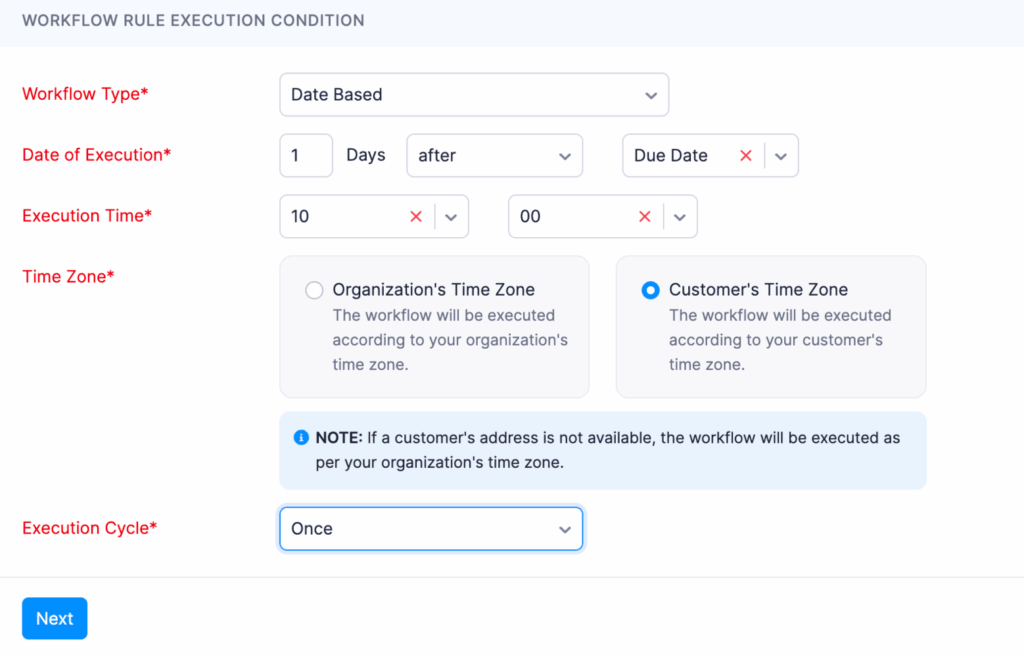
💡 Key Insights
| Category | Details |
|---|---|
| Why it matters | Enables time-accurate automation for customers in different regions — improving experience and precision. |
| How to use it | Go to Settings > Automation > Workflow Rules, and choose the preferred Time Zone context. |
| Our opinion | A must-have for global teams — brings Zoho in line with enterprise-grade automation needs. |
| What to do next | Audit your current workflows and update those involving reminders or time-sensitive actions. |
✅ Quick Takeaway
Stop waking up customers at 2 AM — this update helps ensure all time-triggered workflows hit at the right hour, no matter where your clients are.
WhatsApp Notifications for Packages & Shipments
You can now send package, shipment, and delivery updates to your customers directly via WhatsApp — and track delivery status from within Zoho Books.
This update expands your customer communication toolkit by allowing:
- Pre-configured WhatsApp message templates for shipping updates
- Automatic or manual sending of delivery notifications
- Message status tracking in the Comments & History section of each transaction
This makes order tracking more convenient for customers and less reliant on email.
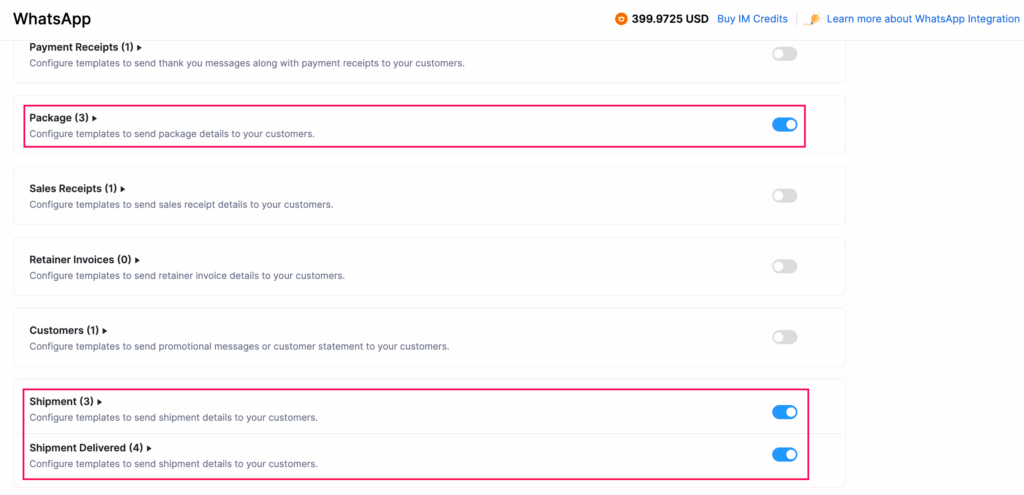
To enable WhatsApp notifications for packages and shipments, go to Settings > Integrations & Marketplace > WhatsApp. Slide the toggle next to Package, Shipment, and Shipment Delivered. You can then create WhatsApp templates and get them approved by Meta to start sending notifications to your customers.
Key Insights
| Category | Details |
|---|---|
| Why it matters | Provides real-time shipment visibility through WhatsApp — a channel customers already use and trust. |
| How to use it | Set up WhatsApp templates under Settings > WhatsApp Integration, then link to package/shipments. |
| Our opinion | A smart, customer-first addition — reduces support calls and builds brand reliability. |
| What to do next | Activate WhatsApp integration, create shipping templates, and test a sample flow with recent orders. |
✅ Quick Takeaway
Deliver delight (literally) — keep your customers informed of package status via WhatsApp, the most widely-used messaging app globally.
New Sales Summary Report
Zoho Books now includes a Sales Summary Report that gives you a day-by-day snapshot of your sales activity, including invoices, receipts, credit notes, and tax-adjusted totals — all in one place.
This new report helps you quickly understand daily sales performance with clear data on:
- Total invoices and sales receipts created each day
- Credit notes issued per invoice (count + amount)
- Outstanding balances after applying credit
- Calculated columns for:
- Total Sales
- Total Sales with Tax (adjusted for credit notes)
This centralises what used to require multiple reports or manual calculation.

💡 Key Insights
| Category | Details |
|---|---|
| Why it matters | Delivers a fast, consolidated view of revenue and returns — helps track trends and reduce manual work. |
| How to use it | Go to Reports > Sales > Sales Summary Report to filter and export daily data. |
| Our opinion | A high-value addition — perfect for finance teams needing agile, day-to-day visibility. |
| What to do next | Schedule this report weekly or monthly. Use it for reconciliations or to flag sales irregularities. |
✅ Quick Takeaway
Make smarter decisions faster — the Sales Summary Report brings daily revenue clarity without data wrangling.
Sort & Limit Data Points in Custom Dashboard Panels
You can now sort and limit the number of data points displayed in report panels within custom dashboards — improving focus and clarity.
Sorting is available for both X-axis and Y-axis values, and the maximum number of items shown can be defined during report panel creation or editing.
Custom dashboards are powerful, but cluttered visualisations can hinder insights. With this update, you can now:
- Sort data points by value or label (ascending/descending)
- Limit the number of data points shown (e.g. top 5 or top 10)
- Apply these options to both axes for maximum control
This gives you sharper visualisations and faster comprehension.
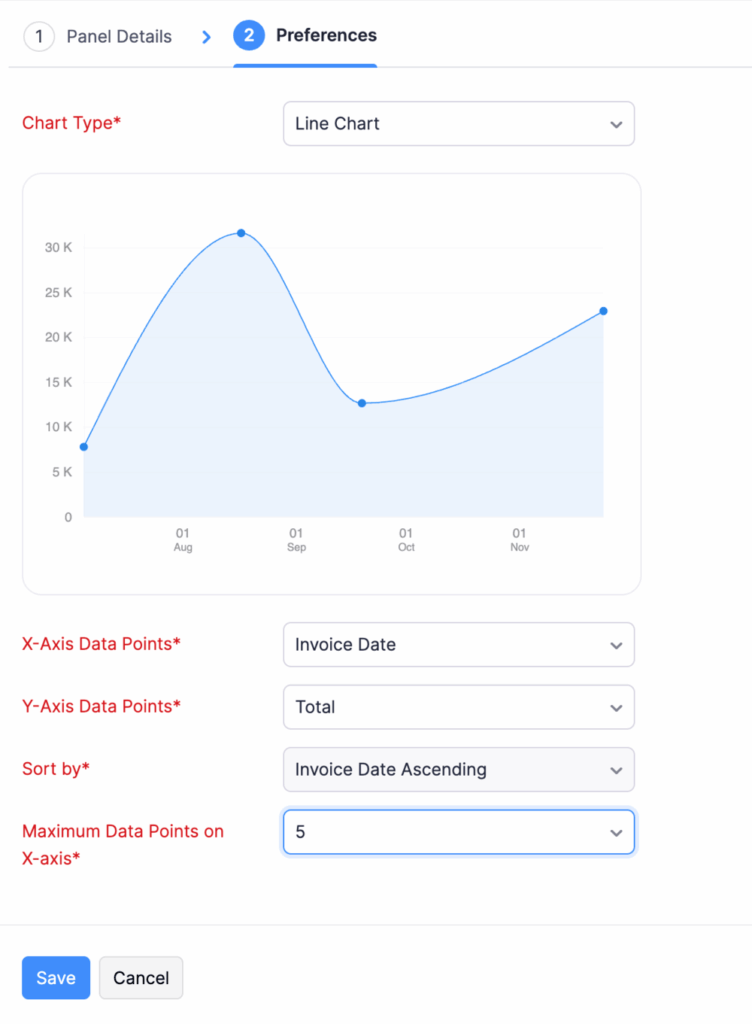
💡 Key Insights
| Category | Details |
|---|---|
| Why it matters | Enables more focused dashboards — surfaces key insights without information overload. |
| How to use it | While creating or editing a report panel, use the Sort and Limit Data Points options. |
| Our opinion | A small change with big UX impact — makes dashboards much more actionable. |
| What to do next | Audit your existing dashboard panels; apply sorting and limits to highlight critical trends. |
✅ Quick Takeaway
Clarity beats clutter — use sorting and limits to make your custom dashboards laser-focused and insight-rich.
Set “Applied On” Date for Customer Payments & Credit Notes
You can now define a custom “Applied On” date when applying customer advances, excess payments, or credit notes to invoices. This lets you apply them at a future date, different from the original posting date.
Previously, credits and advance payments were applied immediately on the posting date, which limited control over when they appeared in reports or reconciliations.
With this update, you can:
- Apply customer advances or credit notes to invoices at a later date
- Reflect the actual application date in your financials
- Improve accuracy in reporting and aging analysis
💡 Key Insights
| Category | Details |
|---|---|
| Why it matters | Provides better control over timing of credit application — helps align with reporting periods or accruals. |
| How to use it | While applying a credit or payment to an invoice, choose the desired “Applied On” date. |
| Our opinion | A precision feature that benefits accounting teams handling complex payment timelines or period closes. |
| What to do next | Educate your AR team on using this for deferred application. Use it during reconciliations or audits. |
✅ Quick Takeaway
You’re no longer locked into the posting date — use “Applied On” to apply credits when it actually happens in your accounting reality.
Enhanced Record Locking with Custom Rules & Roles
Zoho Books has enhanced its record locking capabilities by adding a dedicated tab in Settings and offering more granular control over what can (and cannot) be edited once a record is locked — including who has access to override restrictions.
Previously, record locking was fairly rigid, offering limited control post-lock. This enhancement brings more flexibility and security:
- Access a new Record Locking tab under Settings
- Define specific actions or field edits that are restricted after locking
- Assign user roles or profiles who can still perform certain updates
- Better supports workflows that require controlled edits post-approval or after close
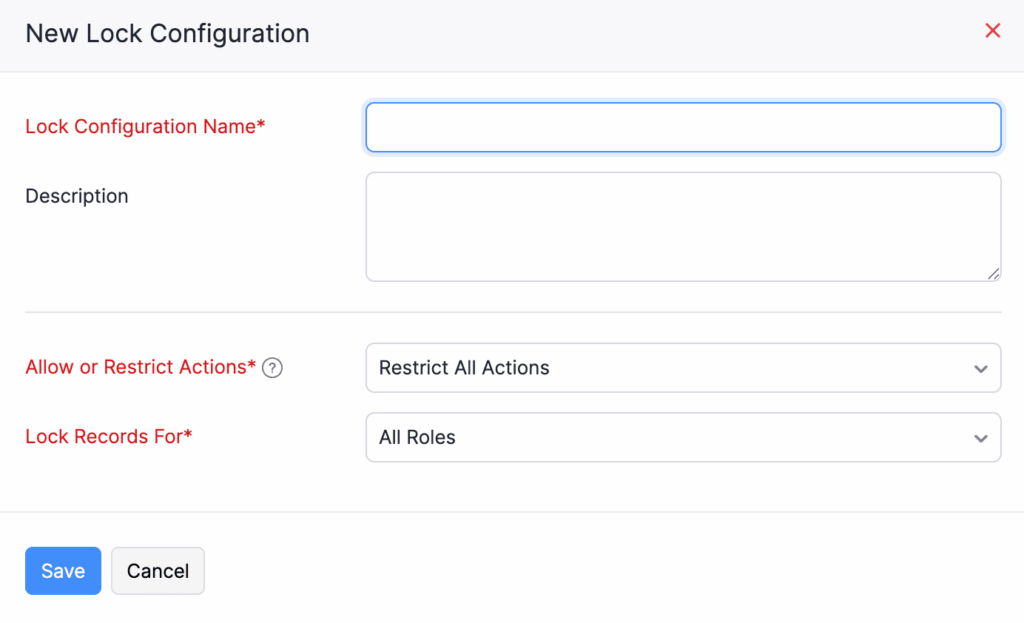
💡 Key Insights
| Category | Details |
|---|---|
| Why it matters | Reduces accidental or unauthorized edits to finalized records — essential for audit trail and compliance. |
| How to use it | Navigate to Settings > Record Locking, configure rules, and assign roles allowed to override them. |
| Our opinion | A strong governance feature — ideal for mid-size to large teams needing controlled access post-lock. |
| What to do next | Review your lock settings. Define who should retain edit rights, and restrict the rest to ensure accuracy. |
✅ Quick Takeaway
Gain better control and audit integrity — this enhancement protects critical records while still allowing trusted overrides where needed.
Zoho Inventory Add-On Updates
Barcode Scanning Now Available in Picklists
You can now use barcode scanners to add or verify items in Picklists — speeding up warehouse operations and reducing manual errors during the picking process.
Picklists previously required users to manually enter or search for items during the picking process. Now, with barcode scanning enabled, you can:
- Scan item barcodes to auto-populate the Picklist
- Quickly verify picked quantities with real-time feedback
- Improve warehouse speed and accuracy with less typing or tapping
This is especially useful in high-volume or fast-moving inventory environments.
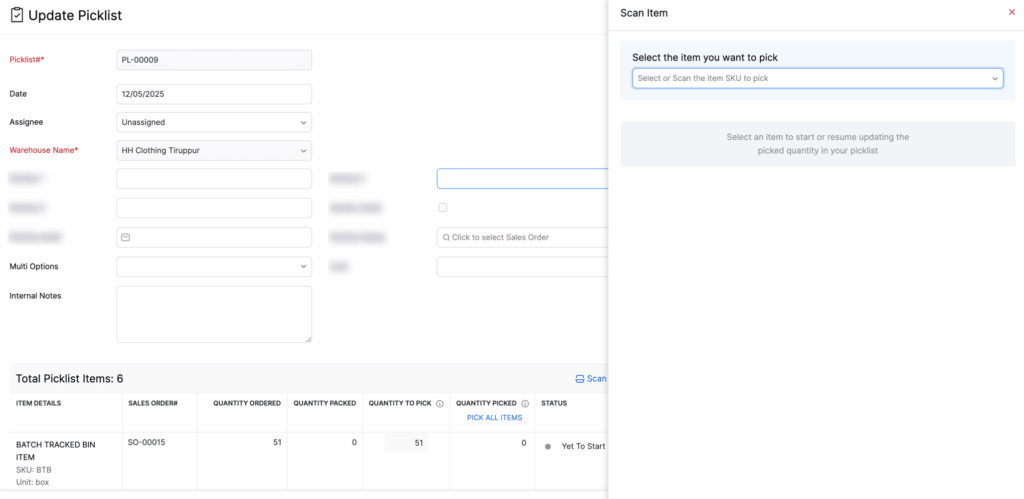
💡 Key Insights
| Category | Details |
|---|---|
| Why it matters | Reduces picking errors and accelerates warehouse fulfillment — a win for accuracy and efficiency. |
| How to use it | Use a barcode scanner in the Picklist interface to scan items instead of selecting them manually. |
| Our opinion | A long-awaited feature for inventory-heavy users — brings Zoho Books closer to full warehouse support. |
| What to do next | Train warehouse staff to use scanners with Picklists. Test the workflow on a few orders to validate. |
✅ Quick Takeaway
No more typing — just scan and pick. This update makes warehouse operations faster, more accurate, and scalable.
Set Preferred Bin for Picklist Creation
Zoho Books now lets you assign a Preferred Bin for each bin-tracked item when creating a Picklist — allowing for more control over where items are picked from in your warehouse.
In warehouse environments with multiple storage bins for the same item, picking accuracy and efficiency rely on knowing where to pull from. This update introduces:
- A Preferred Bin selection option for bin-tracked items
- Admins can set this during Picklist creation
- Pickers are guided to pull items from the designated bin first, reducing ambiguity and walk-time
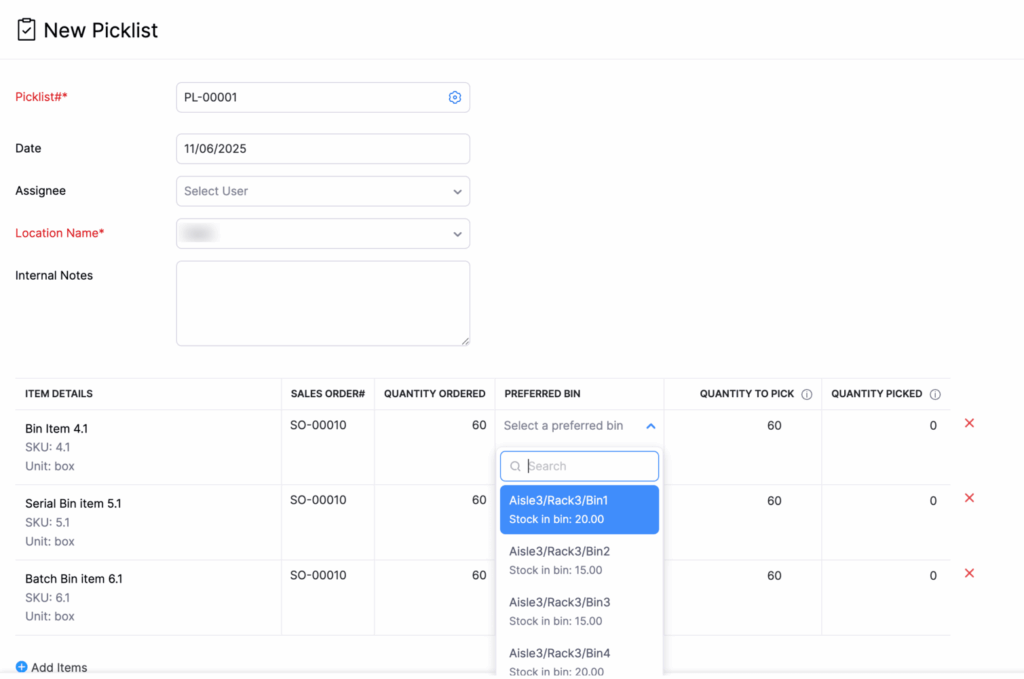
💡 Key Insights
| Category | Details |
|---|---|
| Why it matters | Ensures consistent, efficient item picking from the right bin — reduces inventory miscounts and chaos. |
| How to use it | During Picklist creation, select the Preferred Bin for each bin-tracked item in the list. |
| Our opinion | A smart operational boost — improves warehouse flow and reduces picker decision fatigue. |
| What to do next | Define Preferred Bins for fast-moving SKUs. Update SOPs to reflect this in training. |
✅ Quick Takeaway
Make picking smarter, not harder — Preferred Bins streamline fulfillment by guiding staff to the right shelf, right away.
New Transfer Order Summary & Details Reports
Two new reports have been introduced to improve visibility into your warehouse transfers:
- Transfer Order Summary Report – High-level overview of transfer orders within a date range
- Transfer Order Details Report – Item-level breakdowns for each transfer order
Managing stock movement between warehouses requires clarity on both the order volume and the specific items moved. These two new reports provide that:
- Summary Report: Helps you track how many transfers were made and between which warehouses
- Details Report: Lists every item, quantity, and transfer date to support reconciliation and operational insights
💡 Key Insights
| Category | Details |
|---|---|
| Why it matters | Provides critical tracking of internal stock movement — reduces manual tracking or export juggling. |
| How to use it | Go to Reports > Inventory > Transfer Orders, then choose Summary or Details as needed. |
| Our opinion | A strong reporting addition for growing businesses managing multiple warehouses or high transfer volume. |
| What to do next | Schedule these reports weekly/monthly. Use them to audit transfers and balance warehouse stock levels. |
✅ Quick Takeaway
Get better control over your warehouse logistics with focused reports that highlight both transfer trends and item-level accuracy.
Other Enhancements
- We have added support for viewing sync history in the Bigin integration, making it easier to troubleshoot sync issues.
- You can now manually enter payment numbers while importing vendor payments.
- You can now directly send payment links via WhatsApp.
- You can bulk update the Revenue Recognition fields of an invoice like Revenue Recognition Type, Rule Name, Start Date, End Date, Allocation Method, Deferred Revenue Account.
This Zoho Books update for July 2025 reflects Zoho’s continued commitment to user-driven improvements — with better customisation, smarter automation, and stronger operational visibility. Whether you’re managing multi-location inventory, tracking daily sales, or delivering a seamless customer experience via WhatsApp, there’s something in this release for every team. We recommend reviewing each update, testing relevant features, and sharing this summary with your finance, operations, and customer service leads to maximise adoption and impact.
Want help implementing these features or optimising your Zoho Books setup?
👉 Get in touch with the team at Goldstar IT — we’ll help you make the most of what’s new.
